approximately what proportion of people in the united states are believed to have hypertension?
On this page:
- Defining Overweight and Obesity
- Prevalence of Overweight and Obesity
- Trends in Obesity amid Adults and Youth in the U.s.
Defining Overweight and Obesity
A person whose weight is higher than what is considered to be a normal weight for a given height is described equally existence overweight or having obesity.1
Fast Facts
According to 2017–2018 data from the National Wellness and Nutrition Examination Survey (NHANES)
- Near 1 in iii adults (xxx.seven%) are overweight.2
- More ii in 5 adults (42.4%) take obesity.2
- Most 1 in 11 adults (9.2%) accept severe obesity.2
According to 2017–2018 NHANES data
- Most i in 6 children and adolescents ages ii to xix (xvi.1%) are overweight.3
- Almost one in v children and adolescents ages 2 to nineteen (19.three%) have obesity.iii
- About i in sixteen children and adolescents ages 2 to 19 (six.1%) take severe obesity.3
Using Trunk Mass Alphabetize (BMI) to Judge Overweight and Obesity
BMI is a tool to estimate and screen for overweight and obesity in adults and children. BMI is defined as weight in kilograms divided by height in meters squared. BMI is related to the amount of fat in the torso. A high amount of fat can raise the risk of many health problems. A health intendance professional person can determine if a person'southward health may exist at chance because of his or her weight.
Adults
The table beneath shows BMI ranges for overweight and obesity in adults 20 and older.
BMI of Adults Ages 20 and Older
| BMI | Nomenclature |
|---|---|
| 18.5 to 24.9 | Normal, or healthy, weight |
| 25 to 29.9 | Overweight |
| 30+ | Obesity (including severe obesity) |
| 40+ | Astringent obesity |
Use this online tool from the Centers for Affliction Command and Prevention (CDC) to gauge BMI for adults.
Children and Teens
A child's torso composition changes during growth from infancy into adulthood, and it differs by sexual practice. Therefore, a immature person'south weight status is calculated based on a comparing with other same-age and same-sex activity children or teens using CDC's age- and sexual activity-specific growth charts. The comparison results in a percentile placement. For example, a male child whose weight in relation to his height is greater than 75% of other same-anile boys places in the 75th percentile for BMI and is considered to be of normal or salubrious weight.
Children grow at unlike rates at different times, so it is not always easy to tell if a child is overweight. A child'southward wellness care professional person should evaluate the child's BMI, growth, and potential health risks due to excess torso weight.
BMI for Children and Teens
| Weight Status Category | Percentile Range |
|---|---|
| Underweight | Less than 5th percentile |
| Normal or healthy weight | fifth percentile to less than 85th percentile |
| Overweight | 85th to less than 95th percentile |
| Obesity | 95th percentile or greater |
| Severe obesity | 120% of the 95th percentile |
Use this online tool from the CDC to calculate BMI and the corresponding BMI-for-age percentile based on CDC growth charts, for children and teens.
Causes and Health Consequences of Overweight and Obesity
Factors that may contribute to excess weight gain among adults and youth include genetics; types and amounts of food and drinks consumed; level of physical activity; degree of fourth dimension spent on sedentary behaviors, such as watching TV, engaging with a computer, or talking and texting on the telephone; sleep habits; medical conditions or medicines; and where and how people live, including their access to and power to afford healthy foods and safe places to be agile.4,5
Overweight and obesity increase the take a chance for many health bug, such as blazon 2 diabetes, high blood pressure, heart disease, stroke, joint problems, liver disease, gallstones, some types of cancer, and sleep and breathing bug, among other conditions.5,half-dozen Larn more than about the causes and health consequences of overweight and obesity.
Prevalence of Overweight and Obesity
Adults
Historic period-adjusted pct of US adults with overweight, obesity, and severe obesity past sexual activity, 2017–2018 NHANES Data 2
| All (Men and Women) | Men | Women | |
|---|---|---|---|
| Overweight | thirty.seven | 34.1 | 27.5 |
| Obesity (including severe obesity) | 42.4 | 43.0 | 41.9 |
| Astringent obesity | 9.ii | 6.9 | xi.v |
Equally shown in the above table
- Near one in 3 adults (30.seven%) are overweight.
- More than 1 in 3 men (34.1%) and more than 1 in four women (27.v%) are overweight.
- More than two in 5 adults (42.4%) have obesity (including astringent obesity).
- About 1 in 11 adults (nine.2%) accept severe obesity.
- The pct of men who are overweight (34.i%) is college than the percentage of women who are overweight (27.5%).
- The percent of women who accept severe obesity (11.5%) is higher than the percentage of men who have severe obesity (6.nine%).
Historic period-adjusted prevalence of obesity among adults ages twenty and over, by sexual practice and age: The states, 2017–2018 7
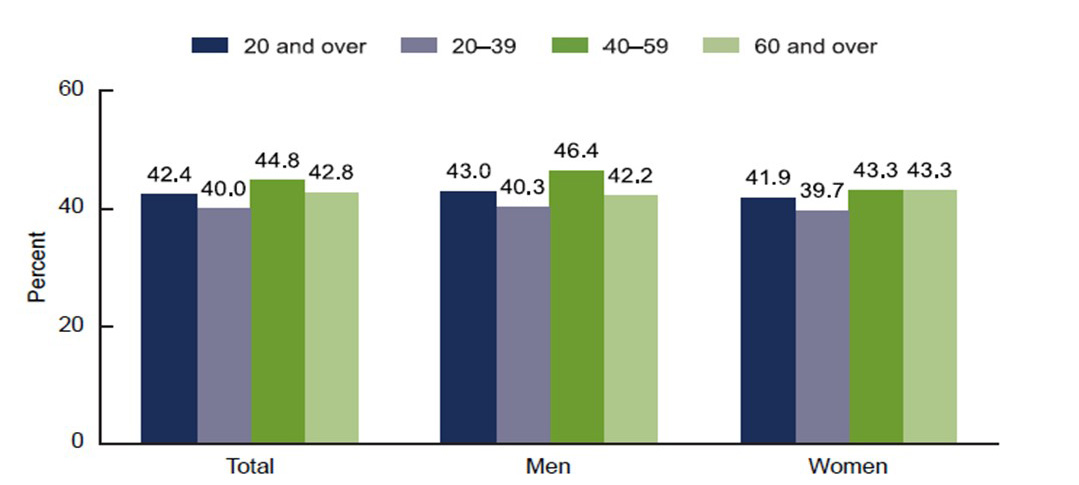 NOTES: Estimates for adults ages 20 and over were historic period adjusted by the direct method to the 2000 U.S. Census population using the age groups 20–39, 40–59, and 60 and over. Crude estimates are 42.5% for total, 43.0% for men, and 42.one% for women. Access data tabular array for Figure 1 (PDF, 97.2 KB) .
NOTES: Estimates for adults ages 20 and over were historic period adjusted by the direct method to the 2000 U.S. Census population using the age groups 20–39, 40–59, and 60 and over. Crude estimates are 42.5% for total, 43.0% for men, and 42.one% for women. Access data tabular array for Figure 1 (PDF, 97.2 KB) .
SOURCE: National Center for Health Statistics, National Health and Nutrition Exam Survey, 2017–2018.
As shown in the above bar graph
- Amongst adults ages 20 and over, there are no significant differences in prevalence of obesity by sex or age grouping
Age-adjusted prevalence of obesity amid adults ages 20 and over, by sexual practice, race, and Hispanic origin: United States, 2017–2018 7
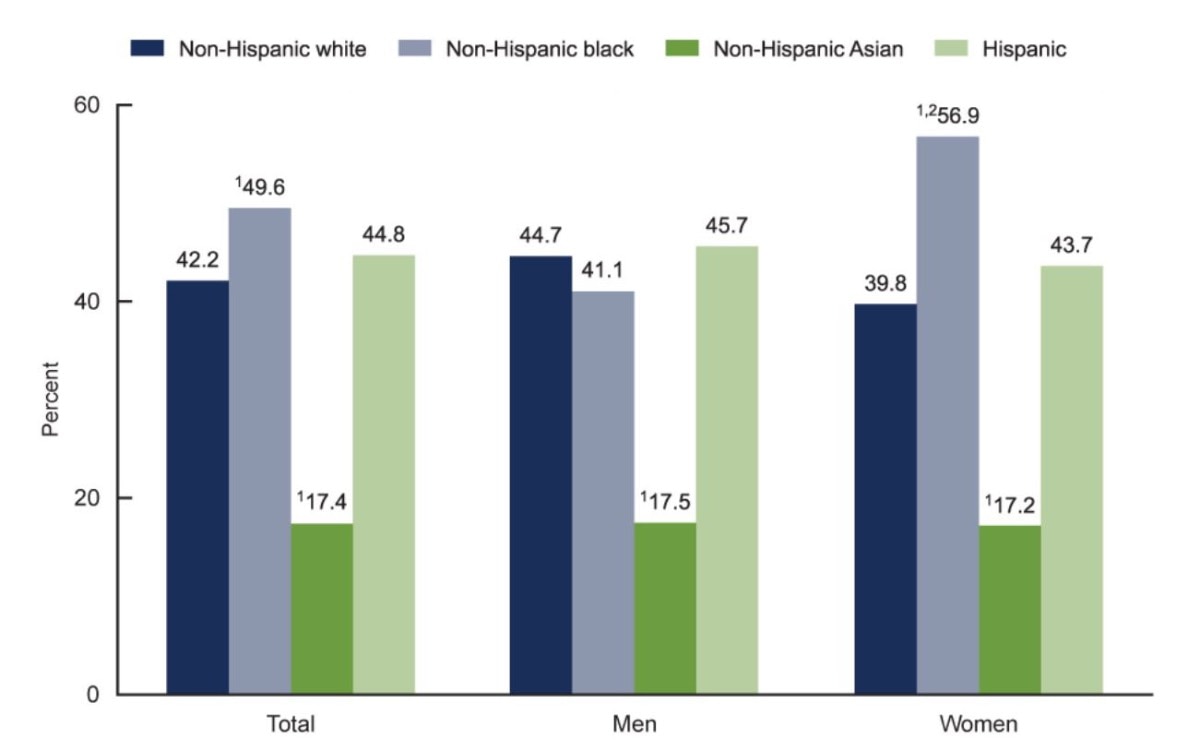 1Significantly different from all other race and Hispanic-origin groups.
1Significantly different from all other race and Hispanic-origin groups.
2Significantly unlike from men for same race and Hispanic-origin group.
NOTES: Estimates were age adjusted by the straight method to the 2000 U.South. Census population using the age groups 20–39, 40–59, and sixty and over. Access data table for Figure 2 (PDF, 97.2 KB) .
SOURCE: National Middle for Wellness Statistics, National Health and Nutrition Examination Survey, 2017–2018.
Every bit shown in the above bar graph
- More than 2 in 5 non-Hispanic white adults (42.2%) have obesity.
- Almost i in ii not-Hispanic Black adults (49.half-dozen%) take obesity.
- More than 1 in half-dozen not-Hispanic Asian adults (17.4%) take obesity.
- Nearly i in ii Hispanic adults (44.8%) have obesity.
- Obesity affects more than ii in 5 non-Hispanic white men (44.7%), more than 2 in v not-Hispanic Black men (41.ane%), more one in 6 non-Hispanic Asian men (17.5%), and more than 2 in 5 Hispanic men (45.seven%).
- Nearly ii in 5 not-Hispanic white women (39.8%), more than half of non-Hispanic Black women (56.9%), more than one in half-dozen non-Hispanic Asian women (17.2%), and more than 2 in v Hispanic women (43.7%), have obesity.
Age-adjusted prevalence of astringent obesity among adults ages xx and over, by sex, historic period, and race and Hispanic origin: United states of america, 2017–2018 7
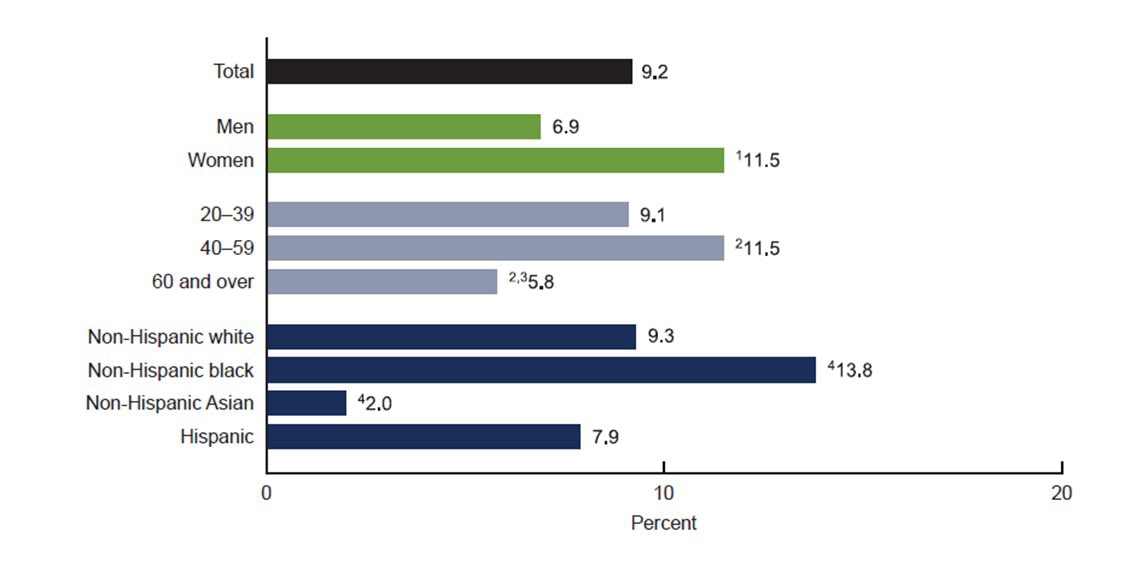 iSignificantly different from men.
iSignificantly different from men.
iiSignificantly dissimilar from adults ages 20–39.
3Significantly different from adults ages 40–59.
fourSignificantly different from all other race and Hispanic-origin groups.
NOTES: Estimates for adults ages 20 and over were historic period adjusted by the direct method to the 2000 U.South. Census population using the age groups 20–39, 40–59, and sixty and over. Crude estimates are 9.0% for total, 6.8% for men, and eleven.ane% for women. Access data table for Figure 3 (PDF, 97.2 KB) .
SOURCE: National Eye for Health Statistics, National Health and Diet Test Survey, 2017–2018. Every bit shown in the to a higher place bar graph, men and women differ in their rates of obesity and severe obesity.
- More women (11.5%) than men (vi.nine%) have severe obesity.
- Severe obesity was highest amidst people ages forty to 59 (eleven.five%), followed by people ages twenty to 39 (9.1%) and people ages 60 and older (5.8%).
- Nearly 1 in 11 non-Hispanic white adults (9.3%) take severe obesity.
- More 1 in viii non-Hispanic Black adults (thirteen.8%) have severe obesity.
- About 1 in 50 not-Hispanic Asian adults (2.0%) have severe obesity.
- Nigh ane in 13 Hispanic adults (7.9%) have severe obesity.
- Severe obesity was highest amidst non-Hispanic Blackness adults (thirteen.8%), followed past non-Hispanic white adults (nine.iii%), Hispanic adults (7.nine%), and non-Hispanic Asian adults (2.0%).
Youth
Prevalence of overweight, obesity, and astringent obesity among children and adolescents ages 2 to 19 years: U.s.a., 2017–2018 NHANES information iii
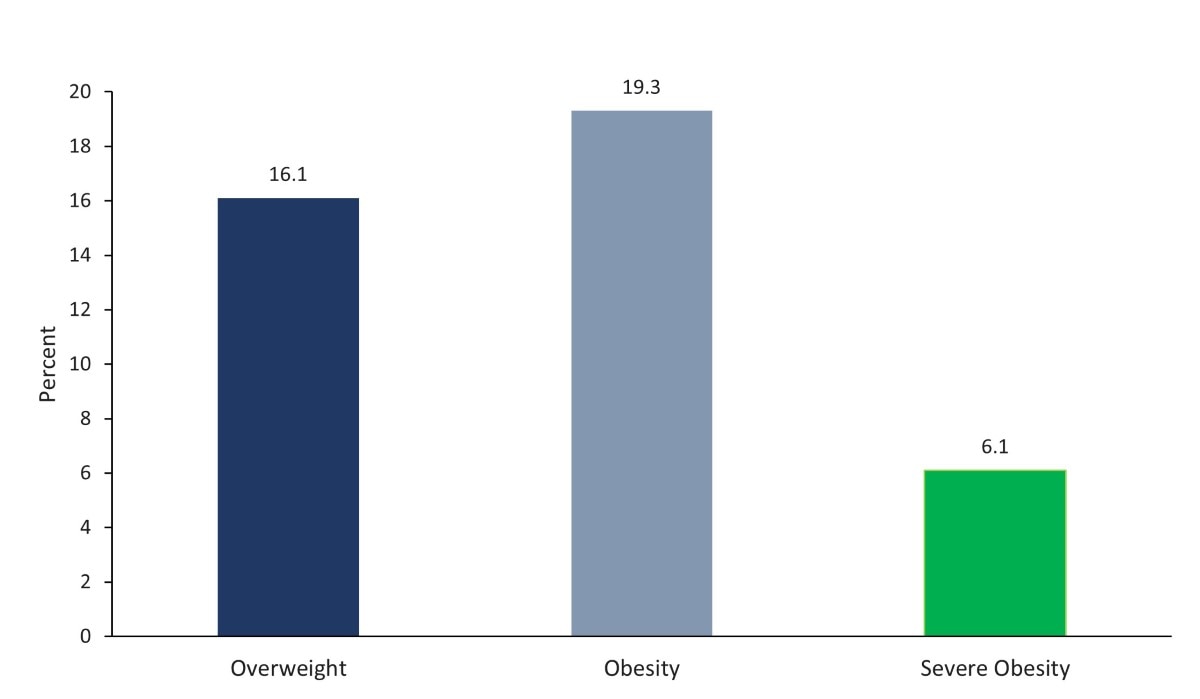 NOTE: Excludes pregnant females. Overweight is body mass index (BMI) at or above the 85th percentile and beneath the 95th percentile from the sex-specific BMI-for-age 2000 CDC Growth Charts. Obesity is BMI at or to a higher place the 95th percentile. Severe obesity is BMI at or in a higher place 120% of the 95th percentile.
NOTE: Excludes pregnant females. Overweight is body mass index (BMI) at or above the 85th percentile and beneath the 95th percentile from the sex-specific BMI-for-age 2000 CDC Growth Charts. Obesity is BMI at or to a higher place the 95th percentile. Severe obesity is BMI at or in a higher place 120% of the 95th percentile.
SOURCE: National Center for Health Statistics, National Health and Diet Examination Survey.
Graphic representation created by the NIDDK. Co-ordinate to the 2017–2018 NHANES data
- Among children and adolescents ages two to 19, about 1 in vi (16.1%) are overweight, more than 1 in 6 (19.3%) have obesity, and nigh 1 in xviii (half-dozen.1%) have severe obesity.
Prevalence of obesity among children and adolescents ages ii to nineteen years: United states, 2017–2018 NHANES data 3
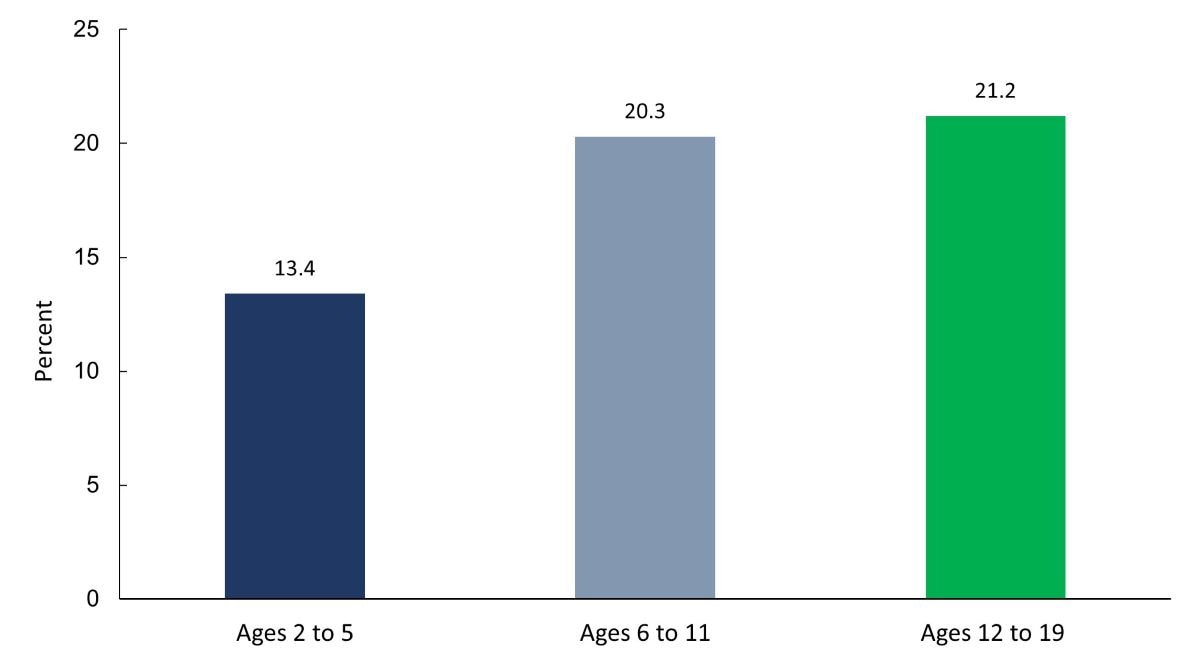 NOTE: Excludes meaning females. Overweight is trunk mass index (BMI) at or to a higher place the 85th percentile and below the 95th percentile from the sex-specific BMI-for-age 2000 CDC Growth Charts.
NOTE: Excludes meaning females. Overweight is trunk mass index (BMI) at or to a higher place the 85th percentile and below the 95th percentile from the sex-specific BMI-for-age 2000 CDC Growth Charts.
SOURCE: National Center for Health Statistics, National Health and Diet Examination Survey.
Graphic representation created by the NIDDK. Co-ordinate to the 2017–2018 NHANES information
- Amongst children ages 2 to five, more than than i in eight (13.4%) have obesity.
- Among children and youth ages half dozen to 11, more than 1 in v (20.iii%) have obesity.
- Among adolescents ages 12 to 19, more than than 1 in v (21.ii%) have obesity.
Prevalence of obesity among children and adolescents ages two to xix years, by sex activity and race and Hispanic origin: Us, 2017–2018 NHANES data 3
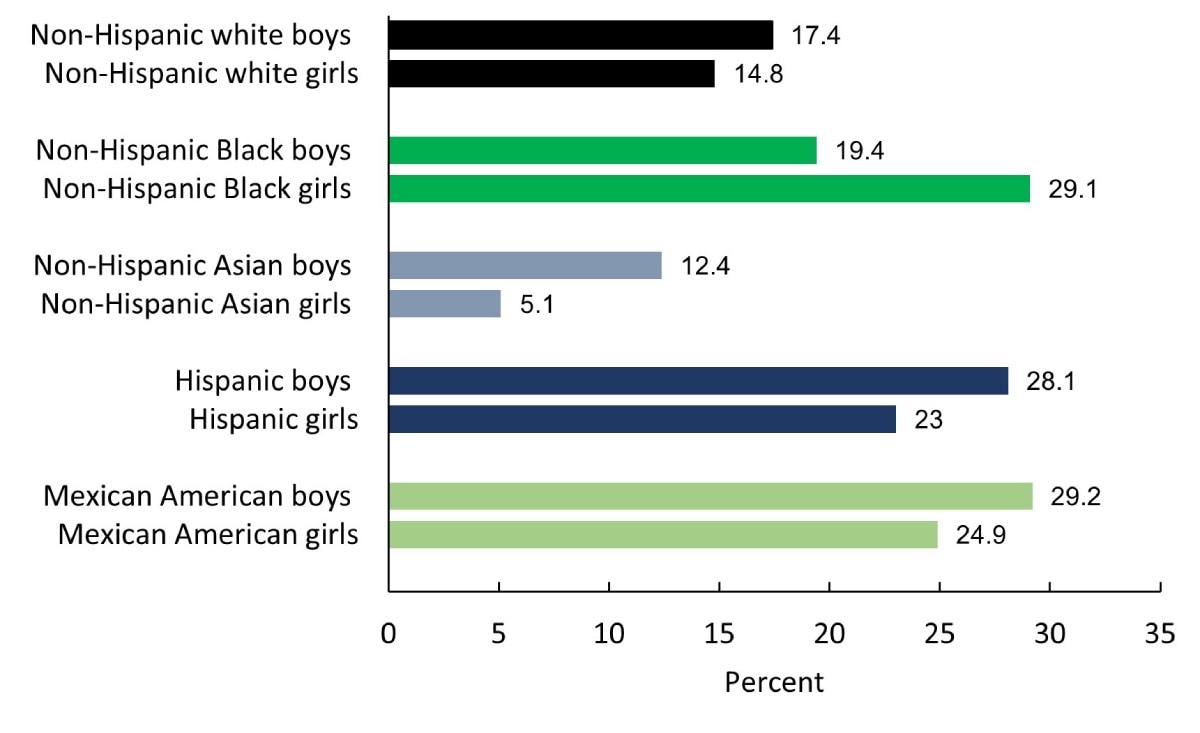 NOTE: Excludes significant females. Obesity is body mass index (BMI) at or above the 95th percentile from the sex-specific BMI-for-age 2000 CDC Growth Charts.
NOTE: Excludes significant females. Obesity is body mass index (BMI) at or above the 95th percentile from the sex-specific BMI-for-age 2000 CDC Growth Charts.
* Gauge has a confidence interval width between 5 and 30 and a relative confidence interval width greater than 130%, and it does non come across National Center for Health Statistics (NCHS) standards of reliability; see Serial Report 2, Number 175 (PDF, 1.6 MB) .
SOURCE: NCHS, National Health and Diet Exam Surveys, 1988–1994 and 1999–2018.
Graphic representation created by the NIDDK. According to the 2017–2018 NHANES data
- More than than 1 in vi non-Hispanic white boys (17.4%) have obesity and more than than 1 in 7 non-Hispanic white girls (14.viii%) accept obesity.
- Most 1 in v non-Hispanic Black boys (19.four%) and more ii in 7 non-Hispanic Blackness girls (29.1%) have obesity.
- Nigh 1 in viii non-Hispanic Asian boys (12.4%) and about 1 in 20 non-Hispanic Asian girls (5.one%*) have obesity.
- About two in 7 Hispanic boys (28.one%) and nearly 1 in 4 Hispanic girls (23.0%) have obesity.
- More than than 2 in vii Mexican American boys (29.ii%) and ane in 4 of Mexican American girls (24.9%) take obesity.
* See asterisked note in the figure above.
Trends in Obesity among Adults and Youth in the United States
Adults
Trends in age-adjusted obesity and severe obesity prevalence among adults ages 20 and over: United States, 1999–2000 through 2017–2018 seven
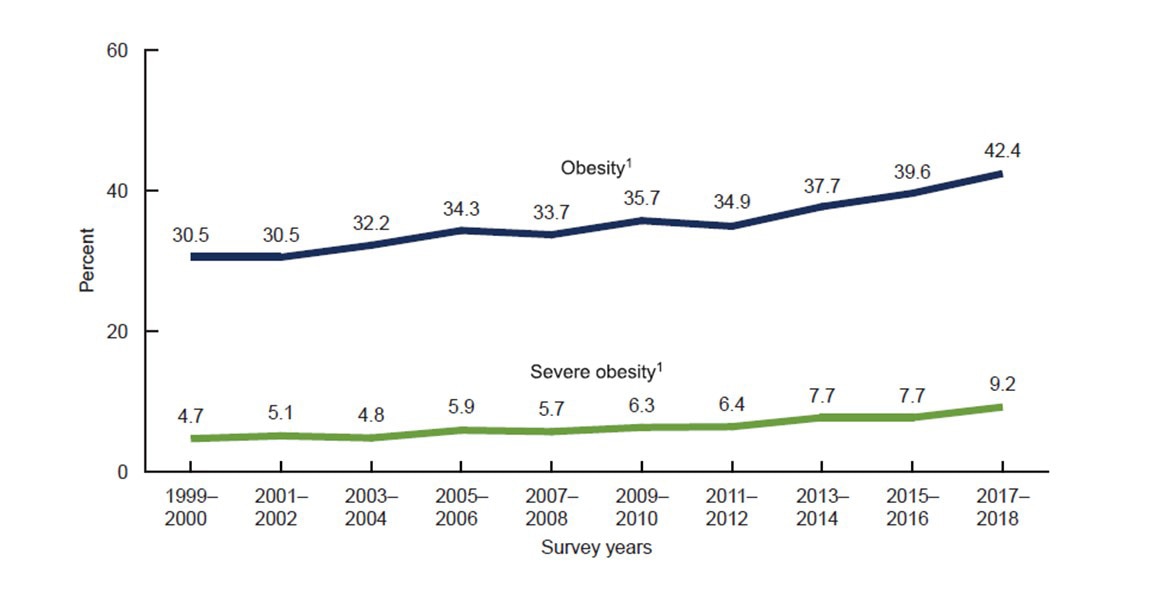 1Significant linear trend.
1Significant linear trend.
NOTES: Estimates were age adapted by the straight method to the 2000 U.S. Census population using the age groups 20–39, 40–59, and sixty and over. Access data tabular array for Figure 4 (PDF, 97.2 KB) .
SOURCE: National Eye for Health Statistics, National Health and Nutrition Examination Survey, 1999–2018. As shown in the figure above
- The prevalence of obesity and severe obesity increased significantly among adult men and women between 1999–2000 and 2017–2018.
Youth
Trends in obesity among children and adolescents ages 2–19 years, past historic period: United States, 1963–1965 through 2017–2018 3
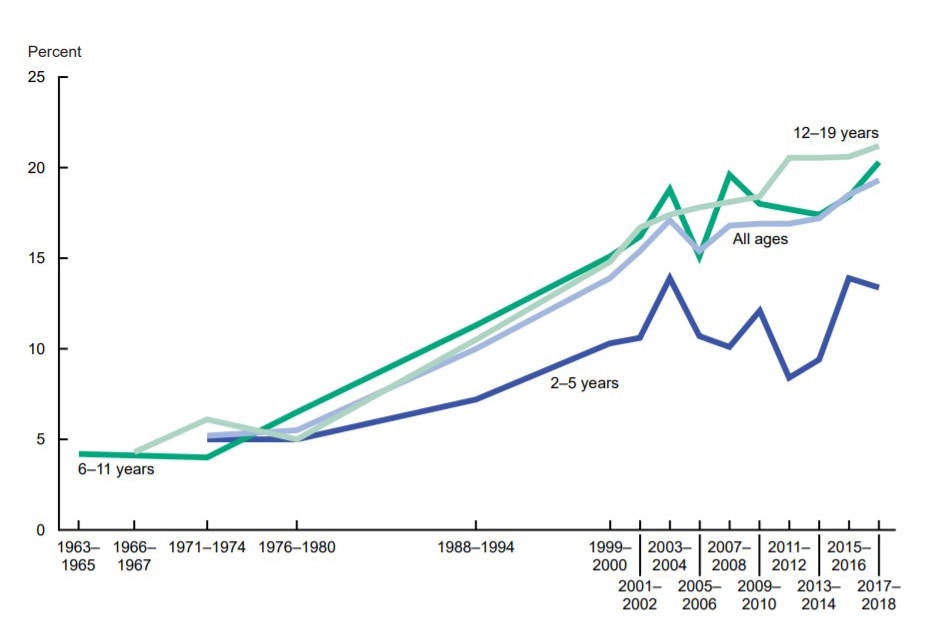 NOTE: Obesity is divers as body mass index (BMI) at or to a higher place the 95th percentile from the sex activity-specific BMI-for-age 2000 CDC Growth Charts.
NOTE: Obesity is divers as body mass index (BMI) at or to a higher place the 95th percentile from the sex activity-specific BMI-for-age 2000 CDC Growth Charts.
SOURCES: National Centre for Health Statistics, National Wellness Examination Surveys Ii (ages half-dozen–xi) and III (ages 12–17); and National Health and Nutrition Examination Surveys (NHANES) I–3, and NHANES 1999–2000, 2001–2002, 2003–2004, 2005–2006, 2007–2008, 2009–2010, 2011–2012, 2013–2014, 2015–2016, and 2017–2018.
As shown in the above line graph
- The prevalence of obesity amid children and adolescents ages ii to 19 years roughly doubled between 1988–1994 and 2017–2018.
- Among children ages 2 to 5, the prevalence of obesity increased betwixt 1988–1994 and 2003–2004, decreased between 2003–2004 and 2011–2012, and so increased again.
- Among children ages 6 to 11, the prevalence of obesity increased betwixt 1988–1994 and 2003–2004, fluctuated over the next several years, and most recently (2013–2014 to 2017–2018) increased.
- Amid adolescents, ages 12 to 19, the prevalence of obesity has increased between 1988–1994 and 2017–2018.
References
Source: https://www.niddk.nih.gov/health-information/health-statistics/overweight-obesity
0 Response to "approximately what proportion of people in the united states are believed to have hypertension?"
Post a Comment